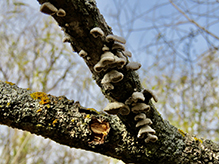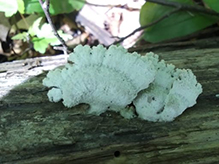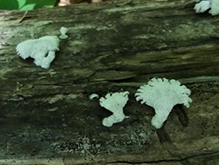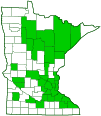Split Gill
(Schizophyllum commune)
Conservation • Description • Habitat • Ecology • Distribution • Taxonomy
|
|
||||||||||||||
Description |
Split Gill is one of the most common and widespread mushrooms on the planet. It occurs on six continents, absent only from Antarctica, where there are no trees to support it. It is also one of the best studied fungi species. The genome was sequenced in in 2010, and it is often used in the laboratory because it fruits so readily. It is found scattered, in small groups, in rows, or in fused clusters, on stumps, logs, and sticks of dead hardwood, especially oak. Worldwide it is found decomposing more than 150 different species. It is saprobic, obtaining its nutrients from decaying wood. There is no stalk but the narrowed point of attachment on some individuals resembles a short stalk. The cap is small, ⅜″ to 19 ⁄16″ in diameter. It may have a narrow base or be shelf-like, broadly attached to the surface (substrate). When attached to the side of a log or stick it is more or less fan-shaped. When attached above or below a log or stick it is irregular to shell-shaped. It is tough, leathery, and thin, both when wet and when dry. The upper surface is dry, densely hairy, and white to grayish-white or gray when dry, sometimes tan when wet. The margin is usually dry and is rolled under when dry. The underside (spore surface) is covered with gill-like folds radiating from the point of attachment. The folds are thick, whitish to grayish, and appear hairy when dry. They are creamy white, smooth, and split down the middle longitudinally when moist. They close up in dry weather, protecting the spores, and open when moistened. The flesh is whitish or grayish, tough, and thin. It is considered inedible in North America and Europe due to its toughness and small size. However, it is used in the cuisines of places with dryer climates, where fleshy mushrooms are difficult to transport to market. The spore print is white. |
Similar Species |
Crimped Gill (Plicaturopsis crispa) has a tan to yellowish cap. The gills are conspicuously wavy. |
Habitat and Hosts |
Scattered or clustered on stumps, logs, and sticks of hardwood, especially oak. |
Ecology |
Season |
Fruits from spring to fall but persists year round |
Distribution |
||
|
Sources |
|
| 6/5/2024 | ||
Occurrence |
||
Very common and very widespread |
||
Taxonomy |
|
Kingdom |
Fungi (Fungi) |
Subkingdom |
Dikarya |
Phylum |
Basidiomycota (Basidiomycete Fungi) |
Subphylum |
Agaricomycotina (Higher Basidiomycetes) |
Class |
Agaricomycetes (Mushrooms, Bracket Fungi, Puffballs, and Allies) |
Subclass |
Agaricomycetidae |
Order |
|
Suborder |
Schizophyllineae |
Family |
Schizophyllaceae |
Genus |
Schizophyllum |
Some mycologists place the genus Schizophyllum in its own order, the Schizophyllales. |
|
Subordinate Taxa |
|
|
|
Synonyms |
|
Agaricus alneus Agaricus multifidus Apus alneus Merulius alneus Merulius communis Schizophyllum alneum Schizophyllum commune var. multifidum Schizophyllum multifidum |
|
Common Names |
|
Split Gill Split Gill Fungus Splitgill Mushroom Split-Gill |
|
Glossary
Saprobic
A term often used for saprotrophic fungi. Referring to fungi that obtain their nutrients from decayed organic matter.
Substrate
The surface on which a lichen or fungi grows.
Multiple Sexes
There are more than 28,000 sexes of Schizophyllum commune defined as distinct pair combinations of alleles at two loci. Each individual is sexually compatible with 27,997 (99.98%) of other individuals worldwide. This may explain why the Harvard study mentioned above was able to successfully mate all of their samples.
Species Complex
Schizophyllum commune is usually treated as a single species. Based on traditional biological species recognition and on morphology, it is a single species with worldwide distribution. This was supported by studies done at Harvard University, where samples collected from all over the world were successfully mated. More recent genetic analysis in 2001 showed it to be a complex of three closely related but distinct phylogenetic species that cannot be reliably distinguished based on their morphology but are genetically differentiated and reproductively isolated. One species occurs in North America and Central America, one in South America, and one in Europe and Asia. Human activity has resulted in migration and population expansion of the three species. Based on phylogenetic species concept (PSC), there are three species. Based on biological species concept (BCS), there are several.
Visitor Photos |
||
Share your photo of this fungus. |
||
This button not working for you? |
||
David Douglas |
 |
Photographed on October 28, 2024 |
Luciearl |
||
 |
 |
|
 |
|
|
... after a light snow, so I imagine the edges are a light dusting of that. |
||
Robert Briggs |
 |
I thought this was a fuzzy white bracket fungus, but I think the gills give it away as being (Schizophyllum commune). Might be the most common fungus in the known universe, but it's the first time I've noticed it. |
MinnesotaSeasons.com Photos |
||

Slideshows |
Schizophyllum commune - fungi kingdom |
About
Published on Jan 25, 2015 Schizophyllum commune - fungi kingdom |

Visitor Videos |
||
Share your video of this fungus. |
||
This button not working for you? |
||
|
Other Videos |
||
|

Visitor Sightings |
||
Report a sighting of this fungus. |
||
This button not working for you? |
||
David Douglas |
Location: Hennepin County (Edina’s Bredesen Park) Photographed on October 28, 2024 |
 |
Luciearl |
Location: Cass County |
 |
| Luciearl 11/14/2021 |
Location: Fairview Twp, Cass County ... after a light snow, so I imagine the edges are a light dusting of that. |
 |
MinnesotaSeasons.com Sightings |
||

Created: 11/2/2016 Last Updated: © MinnesotaSeasons.com. All rights reserved. |


